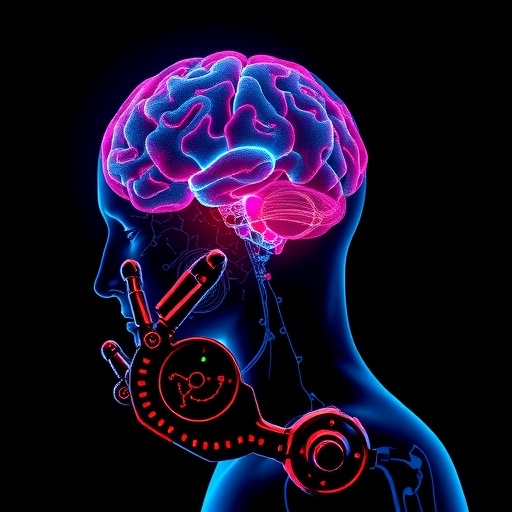In a groundbreaking study conducted at the German Primate Center (DPZ) in Göttingen, researchers have unveiled the intricate neural adaptations that occur when primates learn to control movements within a virtual environment using brain-computer interfaces (BCIs). These insights not only deepen our understanding of motor learning in the brain but also propel forward the future of neuroprosthetics, highlighting how the brain recalibrates motor commands without necessitating structural rewiring of neural networks.
The complex orchestration of precise motor actions—the simple act of shooting a basketball with accuracy, for example—relies heavily on the brain’s ability to predict the outcome of a movement and then adjust accordingly when errors occur. Variations in external factors, such as ball weight or texture, challenge this system, requiring continuous error correction and recalibration. This fundamental principle equally applies to the control of devices through BCIs, where the brain must adapt its motor commands to an artificial output, a process that had remained poorly understood at the neural circuit level until now.
Focusing on the specific brain regions responsible for arm and grasping movements in rhesus monkeys, the researchers employed a sophisticated BCI setup that enabled the animals to manipulate a computer cursor in a three-dimensional space purely through neural activity. By recording population-level neuronal firing patterns from frontal and parietal cortical areas, the study precisely mapped how these regions contribute to motor learning in this artificial context.
Crucially, the research team introduced systematic perturbations into the BCI decoding algorithm, causing the cursor movement on screen to deviate consistently from the monkeys’ intended motions. This novel experimental design forced the animals to adapt their motor commands, creating a unique opportunity to dissect the neural basis of error-driven motor learning. Despite these perturbations, the monkeys’ natural motor functions remained intact, ensuring that observed neural changes were specifically linked to learning adaptation within the BCI framework.
One of the study’s standout findings is the discovery that the brain does not need to rewire its neural connections to accommodate this new mode of movement control. Instead, it leverages pre-existing motor strategies—the neural equivalent of “re-aiming” a movement vector—as a flexible and efficient solution. This phenomenon suggests that BCIs may be inherently easier for users to master than previously assumed because the brain reconfigures output commands within existing networks rather than building new pathways.
The classical view held a strict dichotomy between the frontal and parietal cortices in motor control: the frontal cortex, associated with sending motor commands to muscles, and the parietal cortex, dedicated to predicting sensory outcomes of movement. Unexpectedly, this study revealed that both regions jointly encode the adapted motor commands rather than splitting roles between motor output and sensory expectation. This debunking of the established functional division underscores a more integrated and distributed processing mechanism in motor learning.
This integrated encoding was observed through distinct patterns of neuronal activity that reflected corrective adjustments to motor commands instead of distinct sensory predictions. The experimental paradigm succeeded in disentangling these typically conflated processes by introducing a mismatch between intended and observed movements, a methodological advance that paves the way for deeper insights into sensorimotor integration.
Enrico Ferrea, the lead author, emphasizes the surprising role of the parietal cortex, which exhibited neural activity tied to corrective motor commands rather than merely acting as a sensory integrator. This finding challenges long-held assumptions about parietal function and suggests a far more active role in shaping motor output than previously appreciated, broadening our understanding of the cerebral cortex’s adaptability during motor learning.
Alexander Gail, head of the Sensorimotor Research Group at DPZ, further highlights the translational potential of these findings. By elucidating how the brain recalibrates motor plans, this work informs the design of more intuitive and effective neural prostheses, potentially restoring mobility and function in patients suffering from paralysis or other neuromotor disorders. The emphasis on the brain’s ability to adapt without restructuring suggests that training and rehabilitation protocols could be optimized to harness existing neural circuits efficiently.
The methodology underpinning this research is a blend of advanced neurophysiological recording techniques and cutting-edge machine learning algorithms that decode population-level neural activity in real time. This approach not only allowed for precise control and manipulation of the BCI feedback loop but also enabled detailed longitudinal tracking of neural plasticity during extended motor learning sessions.
Beyond its implications for BCIs, the study contributes broadly to the field of sensorimotor neuroscience, challenging entrenched models of cortical function and motor control. The joint encoding of corrected motor commands across frontal and parietal areas indicates that the cerebral cortex operates via a distributed network mechanism during motor adaptation, rather than modular specialization, opening new avenues for research into cortical dynamics.
Importantly, these insights arise from rigorously controlled experiments in non-human primates whose motor cortical organization closely mirrors that of humans. This relevance suggests that the findings could readily translate to clinical applications, offering a scientifically grounded blueprint for enhancing neuroprosthetic training and rehabilitation strategies.
In summary, this research provides a transformative view of how the brain adapts motor commands during learning under uncertain or altered conditions, particularly in artificial virtual environments mediated by BCIs. The revelations about distributed cortical encoding and the use of existing motor plans for error correction redefine our understanding of neural plasticity, offering hope for improved prosthetic technologies and deeper comprehension of human motor control.
Subject of Research: Animals
Article Title: Frontal and parietal planning signals encode adapted motor commands when learning to control a brain-computer interface.
News Publication Date: 29-Sep-2025
Web References: 10.1371/journal.pbio.3003408
Image Credits: Vladyslav Ivanov, created with AFNI_25.2.18
Keywords: brain-computer interface, motor learning, neural plasticity, sensorimotor integration, frontal cortex, parietal cortex, rhesus monkey, neuroprosthetics, motor adaptation, cortical networks
Tags: brain regions for arm movementsbrain-computer interfaces applicationserror correction in motor actionsfuture of neurotechnology and roboticsmotor learning in primatesneural adaptations for movement controlneural circuit mechanisms in motor commandneuroprosthetics advancementsreal-time brain activity monitoringrhesus monkeys in neuroscience researchthought control of prosthetic limbsvirtual environment training for BCIs





